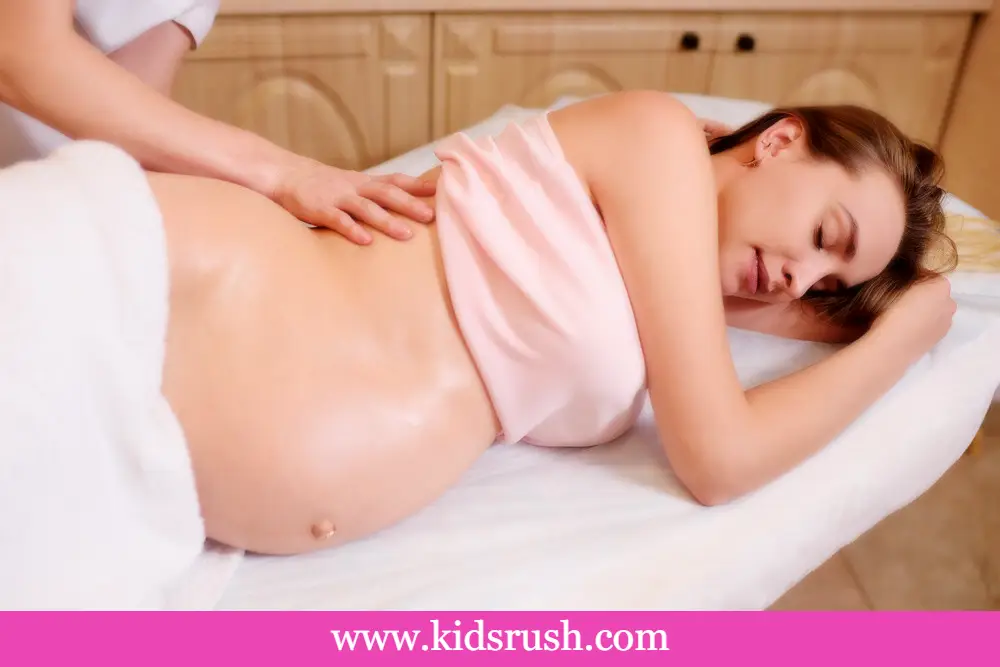Massage is often considered to be a pleasure you can indulge in on occasion. However, it might be one of the most beneficial times for massage during pregnancy.
Pregnancy Massage: What Is It?
Massage during pregnancy encompasses any hands-on treatment given during or after pregnancy (prenatal or postpartum massage).
Pregnancy massage lasts an hour. Some massage therapists use a pregnancy massage table, which is a specially designed table that accommodates a pregnant belly. Some therapists bolster women on their side so that they are comfortably positioned during the massage. A lie-down is among the most comfortable positions, especially in the latter stages of pregnancy.
Read Also: Heterotopic Pregnancy Symptoms, Diagnosis, and Treatment
Pregnancy Massage and Its Benefits

There have only been a few small studies published on massage and pregnancy, so there is no real conclusive proof of its benefits. There are several groups trying to raise awareness with various non profit event ideas and social media campaigns. A study conducted by the University of Miami School of Medicine indicates the following:
- Lowered anxiety
- Leg and back pain decreased
- Improved sleep
- Stress hormone norepinephrine concentrations drop
Researchers also found in another study on pregnancy massage and depression:
- Dopamine production increases as serotonin levels increase.
- Cortisol levels decreased, indicating stress
- A marked improvement in mood
For the general population, research indicates that it can be beneficial to receive massage therapy. For instance, massage may relieve pain, or it may help boost immunity to viruses or tumors.
Pregnancy Massage: Safe Techniques

The United States has more than 1,300 massage schools teaching more than 80 types of massage. Among the most popular types of massages include:
- Firm strokes press the muscles deeply during the deep-tissue massage.
- The Swedish massage involves long, firm strokes that target the muscle groups and stimulate joint mobility.
- It involves pressing acupressure points on the body to boost the flow of energy within it, called qi.
Science has not revealed much about how massage therapy works yet. Further research should be carried out to identify how massage could:
- Relieve pain
- Releasing certain hormones that boost your mood such as serotonin
- Improve your sleep quality
- Promote relaxation by promoting physiological responses.
During pregnancy, a woman’s body goes through many changes and experts tailor their techniques to address these changes. For example, blood volume rises drastically — as much as 50% — during pregnancy. During delivery, blood flow to the legs adversely affects blood clotting. And thus anticoagulant levels in the blood rise as a function of preventing hemorrhage.
These circulatory changes place a pregnant woman at risk for blood clots in her lower legs, typically the calves or inner thighs. For safety, experts recommended relieving the pressure from the legs and avoiding the application of deep massage during pregnancy. They avoid using strong pressure as well as deep acupressure, shiatsu, cross-fiber friction, and percussive tapping on the legs due to a risk of dislodging a blood clot.
Massage the abdomen with light pressure if at all possible. Some masseuses do not massage the abdomen at all.
Is Pregnancy Massage Safe?
A huge gap in training and extensive lack of standards in certification exists in the area of pregnancy massage. Some doctors are reluctant to recommend massage during pregnancy.
Regardless of whether or not a client is pregnant, not every state has laws requiring a massage therapist to complete minimum training as a professional.
Furthermore, like many complementary therapies, massage during pregnancy has not been thoroughly studied with high-quality clinical research methods. In fact, there is no doubt whether it is safe for pregnant women to have a massage during the first trimester.
A miscarriage is a factor that many pregnancy massage experts argue is not due to a pregnancy massage. However, no research has been done to show that miscarriage occurs after a pregnancy massage.
Some doctors and massage therapists who deal with the first-trimester massage refer patients to other practitioners to avoid the potential liability issues should a miscarriage occur while having a massage.
All pregnant women should consult with their doctor before trying massage, according to the National Center for Complementary and Alternative Medicine.
Discover: Abdominal pregnancy: Symptoms, Risk Factors, Diagnosis, and Treatment
Pregnancy Massage: When to avoid it
There are no scientifically established guidelines on massage during pregnancy. Many Western-trained doctors recommend a conservative approach to this treatment. Women who are pregnant are even advised to avoid massages.
- If you are experiencing nausea, vomiting, or morning sickness, set apart a time to take medicine.
- A miscarriage is highly likely in your case.
- Generally, high-risk pregnancy mothers are those who experience placental abruption (where the placenta disconnects from the uterus’ wall) or preterm labor.
If your doctor has given you written consent and you sign a liability waiver form before receiving a pregnancy massage, your therapist may require that you provide written consent and the waiver.
Pregnancy masseuses are trained in what way?
A lot of massage therapy schools offer 500-hour programs. However, most programs can or cannot provide training specifically in pregnancy massage. Many Continuing Education courses and workshops like the one offered by Pamper Me feature a lot of hands-on preparation and experience.
The American Massage Therapy Association, for example, is one of many national associations where you can find a massage therapist who has been qualified and certified.
Get specific information about the therapist’s training and experience in pregnancy massage before you book your first appointment. You might also ask your doctor, midwife, or chiropractor who can refer you to trained providers in your local area.
